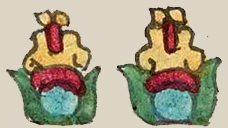xochitl (Mdz2v)
This element for flowers (xochitl) has been carved from the compound sign for the place name, Xochimilco. It consists of two upright flowers in multiple colors. At the base are two green leaves (or perhaps sepals). Inside these are a round turquoise-colored circle (ovary?), with a red cap-like piece. Above that may be yellow petals, a red upright element, and two round yellow balls at the top (seemingly the style, stigma, and anthers).
Stephanie Wood
Glyphs for flowers are often highly detailed and colorful. The attention to detail and color attest to the high value placed on flowers. The two small circles at the top of this flower, the leaves, and the roots are all hallmarks that will recur with some frequency, but, naturally, this element can also be abbreviated in some compound glyphs (e.g. the example, below, from 23 recto), and it will absorb European depictions of flowers (emphasizing stem, leaves, and largely round flowers) over time. Prior to contact, flowers appeared on temples and palaces, they were cultivated in gardens (showing horticultural expertise), they were associated with a ritualized warfare, worn as necklaces and garlands, and, for these reasons and more, they were the subject of poetry. Mexicolore has a short article about the Nahuas' fondness for flowers.
In some flowers, such as these, the anthers are rather pronounced. The anthers are the flower parts that produce and provide the pollen, which has the reproductive capacity that has been compared in Western cultures to semen.
Stephanie Wood
c. 1541, or by 1553 at the latest
Stephanie Wood
flowers, blooms, blossoms

xochi(tl), flowers, https://nahuatl.wired-humanities.org/content/xochitl
flower
la flor
Stephanie Wood
Codex Mendoza, folio 2 verso, https://digital.bodleian.ox.ac.uk/objects/2fea788e-2aa2-4f08-b6d9-648c00..., image 15 of 188.
The Bodleian Libraries, University of Oxford, hold the original manuscript, the MS. Arch. Selden. A. 1. This image is published here under the UK Creative Commons, “Attribution-NonCommercial-ShareAlike 3.0 License” (CC-BY-NC-SA 3.0).

